Armored car Isotta Fraschini RM. The first armored car in Italy
Until 1911, the Italian company Izotta-Fraschini was one of the leading manufacturers of automotive vehicles and was present only on the market for commercial vehicles. Nevertheless, over time, the company management came to the conclusion that it was necessary to create new projects in the field of military equipment. Abroad at this time there were more and more new projects of armored vehicles, which could be considered a full-fledged trend. In addition, tensions in North Africa escalated, threatening to enter the stage of open armed conflict.
Seeing the latest trends in the field of military equipment and taking into account the needs of the army, in 1911, the company Isotta Fraschini, on its own initiative, began developing its first armored car. It should be noted that before the company "Izotta-Fraschini" Italian engineers were not engaged in the creation of such technology. Therefore, the new armored car was not only the "debut" for the developer company, but also the first representative of its class, created in Italy. Having no experience in creating armored vehicles, the Italian designers decided to use the existing chassis of a commercial truck on which it was planned to mount all the necessary units.
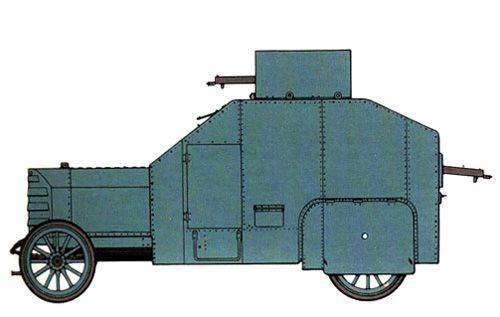
The development of the new armored car, called the Isotta Fraschini RM (also known as Mod.1911), was headed by the designer Giustino Cattaneo. For obvious reasons, the new project was to some extent experimental, and its creators did not initially count on special attention from the army. Their main task was to test several basic ideas, as well as gain experience in the field of designing armored vehicles. The possible mass production of the armored car and the orders of the army in this case turned out to be a pleasant addition to collecting the necessary information.
Like many other designers of armored cars of that time, the specialists of Izotta-Fraschini decided to build their car on the basis of an existing truck. As the basis for the Mod.1911 armored car, the chassis of one of the production vehicles with the wheel formula 4х2 was taken. It was proposed to use the chassis without making major changes to its design. In this case, it was possible to check all the new ideas, and also to do without complicated work and save on the production of the prototype armored car.
The base chassis of the Isotta Fraschini RM armored car had a typical construction for that time. Bottom on a rectangular frame fastened elements of the chassis, namely leaf springs of two bridges. On top of the frame there were attachments for the engine, gearbox and other elements of the power plant. It was decided to make some changes in the design of the chassis, aimed at improving the performance of the combat vehicle. The base chassis had single wheels (according to other data, twin wheels were installed on the rear axle) without cameras. In the RM project, it was proposed to equip the front wheels with an additional rim protruding beyond the side plane of the tire. These parts, as conceived by the designers, should have increased the machine’s permeability on soft soils. The rear axle of the chassis, in turn, received twin wheels without additional rims (as already mentioned, according to other data, twin wheels were present on the chassis initially).
In front of the base chassis, an Isotta Fraschini I4 gasoline engine with an HP 40 power was mounted. Behind him was a manual gearbox connected to the drive shaft. Engine torque was transmitted to the rear drive wheels. Due to the lack of necessary experience and, probably, unwillingness to complicate the design, the first Italian armored car was not all-wheel drive.
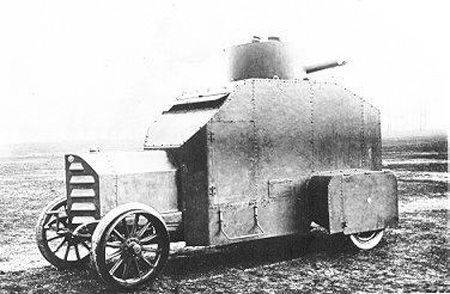
Armored car Isotta Fraschini in the basic version
For installation on the base chassis, an original armor hull was proposed, designed to protect the crew and units from enemy fire. The Izotta-Frascini armored car Mod.1911 was proposed to be built according to a bonnet scheme with the division of the internal volume of the hull into two parts. The front compartment of a smaller volume had to accommodate the power plant, the larger rear - the crew and weapons. Most of the armored cars of that time had similar architecture, since it allowed using the available volumes with maximum efficiency.
Like other armored cars, the Isotta Fraschini RM had a characteristic shape, formed by a large number of smooth metal panels. Thus, the engine compartment was assembled from two vertical side and two inclined upper sheets. In front of the motor, it was protected by sheets with cut-out blinds for ventilation installed at an angle to the machine axis. Behind the engine compartment, the hull increased in size, and for smooth interfacing of the larger part of the hull with the engine compartment, several armor plates were used installed at an angle to the horizontal and vertical.
To reduce the weight of the structure and save armor steel, the front sheet of the habitable volume was located at a large angle to the vertical. It had a viewing hatch, equipped with a lowered lid with slits. In a combat situation, the cover was supposed to protect the crew from enemy bullets. A similar bevel was present in the aft hull. At the same time, the manned compartment of the hull, with the exception of a narrowing front part, had a rectangular shape.
On the roof of the body of the armored car there was a cylindrical swivel tower, which apparently did not have a roof. It was proposed to install one of the machine guns. There was a partial protection of the undercarriage: while the front wheels were outside the body and did not have protection, the center and rear parts of the frame were covered with its lower part. In addition, two relatively large boxes were provided in the stern, which served as wings and protected the rear wheels from shelling.
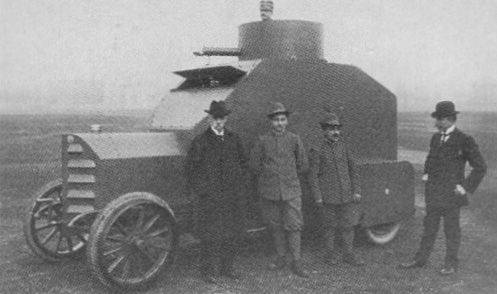
The body of the machine "Izotta-Frascini" Mod.1911 was assembled from sheet armor with a thickness of 4 mm. During the assembly of an armored car on the base chassis, a frame of metal profiles was mounted on which armor was fastened with the help of rivets. Thus, the proposed machine was fairly simple in production and, from the point of view of technology, fully corresponded to the level of industrial development at the beginning of the 20th century.
The crew of the Isotta Fraschini RM armored car was to consist of three people: the driver, the commander and the gunner. According to others, the car was driven by four fighters, including two shooters. Regardless of their size, all crew members were located inside a protected corps and should not have left it during combat operations. The driver and, presumably, the commander was located in front of the habitable volume. One of the shooters was located in the central part of the combat compartment and controlled tower armament, the second shooter was located in the stern. Access to the inside of the body was through a door in the port side.
The armament of the first Italian armored car consisted of two machine guns with a water-cooled barrel. One of them was installed in the tower and allowed circular fire. The second machine gun was placed in the embrasure of the hull's stern sheet. According to some information, initially the Mod.1911 armored car had only a turret machine gun, and the stern appeared later, in an updated version of the project.
The first Italian armored car had a combat mass of no more than 3 tons. When using an 40 horsepower engine. he could reach the highway speeds up to 60 km / h. When traveling over rough terrain, the speed of the car was significantly reduced. In addition, despite all the modifications of the chassis, aimed at improving the patency, the Isotta Fraschini RM armored car could not move on certain types of surface.
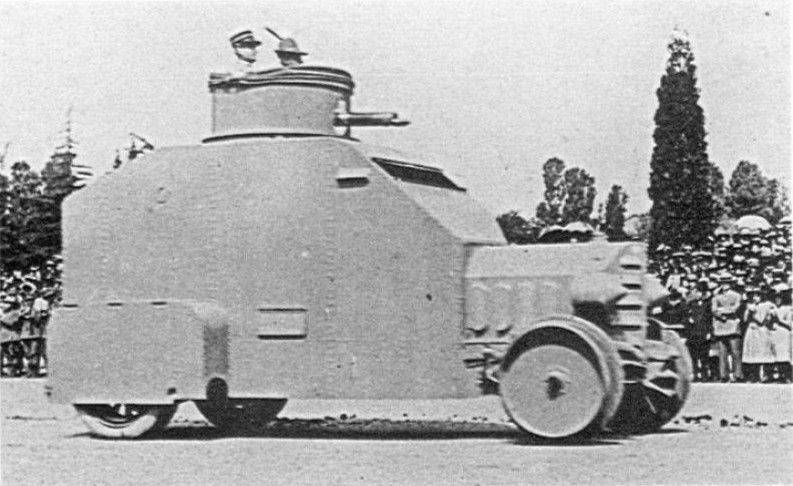
Modified version of the machine
The exact number of armored cars Mod.1911 is unknown: different sources provide different information. In addition, determining the number of such machines is hampered by the fact that the surviving photographs depict armored cars that have noticeable external differences. Thus, it can be assumed that at least two new model cars were built. However, it has the right to life and another assumption, according to which there was only one armored car, and the differences in the photographs are due to its refinement.
One way or another, the first prototype of the Izotta-Fraschini RM armored car was built in 1911. Later he passed the test, the results of which, probably, it was decided to finalize the project to improve the performance of the machine. As a result, the second copy (if it really existed) or the first prototype received several noticeable changes.
Apparently, during the tests, the engine overheated due to poor ventilation of the engine compartment. The solution to this problem was the appearance of hacked blinds on the sides of the hood. In addition, on the outer surface of the engine compartment, two relatively large headlights appeared in cylindrical protective bulletproof covers with conical front covers.
For greater comfort of the tower shooter and the entire crew, the open tower received a cloth awning. If necessary, they could close the top of the tower, preventing rain water or snow from getting inside the armored vehicle. Presumably, during the modifications in front of the right side of the hull, a small viewing slot with a lid appeared. According to some information, it was during the modernization of the armored car received a second machine gun mounted in the stern of the hull.
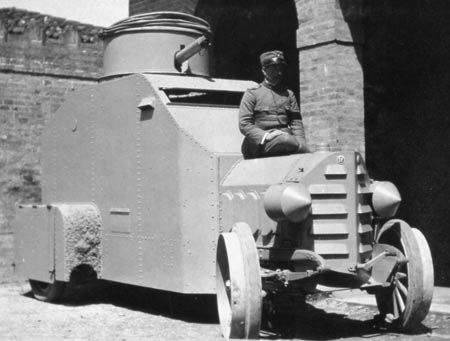
One or two prototypes of the Isotta Fraschini RM armored car were tested, during which, as follows from the available data, they showed good performance. However, the Italian military showed no interest in this technique, which is why it did not go into the series. The exact reasons for this decision are unknown. Probably, the new armored cars did not fit into the existing strategy of the army, and its refinement was considered inexpedient.
As a result, no more than two Mod.1911 experienced armored vehicles were built, after which the assembly of this technology stopped. Some sources mention that one of the cars built was able to participate in the battles. After completing the tests, one of the prototypes was delivered to Libya, where it was used in limited battles with the Turkish army. The details of these operations have not been preserved, but it can be assumed that, with proper use, even one such armored vehicle could seriously affect the results of the battle.
After the end of the Italian-Turkish war, the only “combat” armored car Isotta Fraschini RM returned to Italy. In the future, having no prospects, the car (or car) for some time stood idle at the factory. The first Italian armored car did not become a museum exhibit. With promising technology, most likely, it was treated severely, but practically and according to the customs of that time. The armored hull was disassembled and went to the smelter, and the base chassis became the basis for one of the serial commercial trucks.
Based on:
http://aviarmor.net/
http://panzercentral.com/
http://shushpanzer-ru.livejournal.com/
http://cimeetrincee.it/
Bartholomew E. Early Armored Cars. Oxford, UK. Shire Publications Ltd, 1988
Information